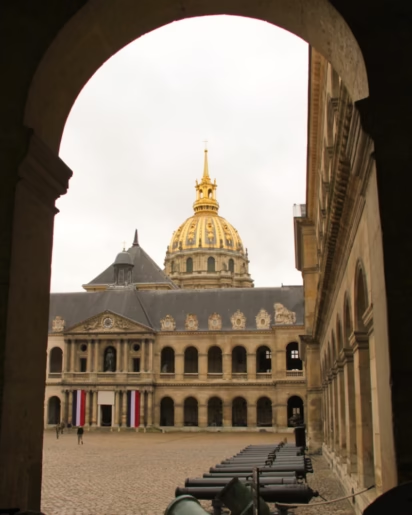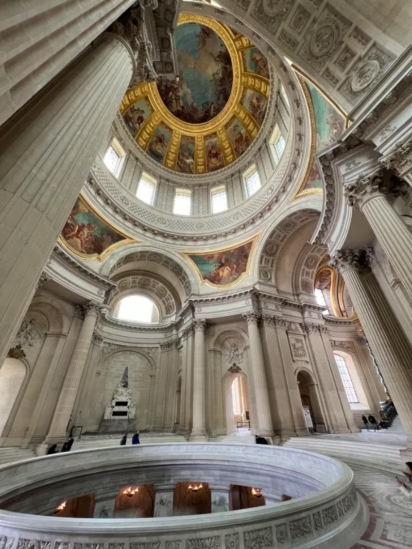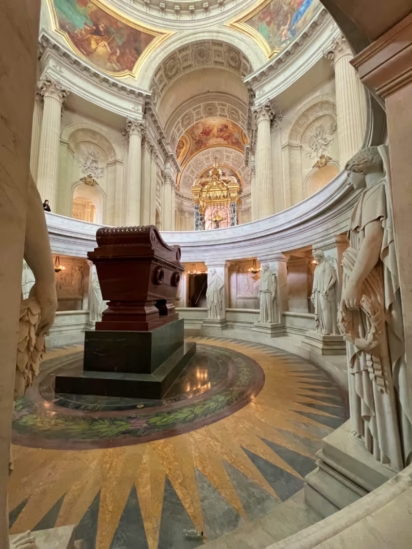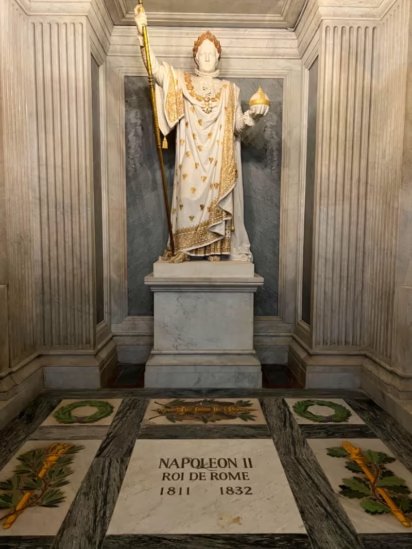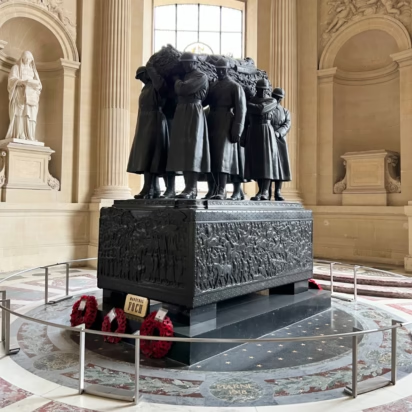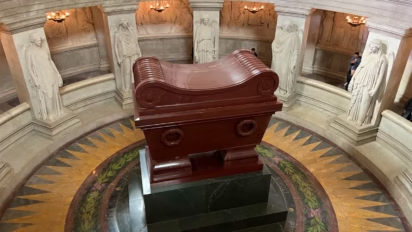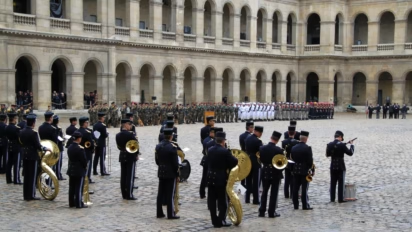Napoleon’s monumental tomb is in the crypt of the Dôme des Invalides in Paris and is seen when visiting the Army Museum (Musée de l’Armée).

The Tomb of Napoleon I Bonaparte is in the crypt of the Dôme des Invalides in the larger Hôtel National des Invalides complex of the Musée de l’Armée, one of the largest museums of military history and art in the world. Tickets for the Army Museum cover the entire complex but a separate entrance makes it easy to visit just Napoleon’s Tomb. Separate Dôme-only tickets are not sold (except for the Aura nighttime lights show) but the Paris Museum Pass is valid. Guided tours of the Army Museum and combination savings tickets are often available.
Army Museum and Napoleon’s Tomb in Paris
The Army Museum (Musée de l’Armée) and Napoleon’s Tomb (Tombeau de Napoléon) are inside the huge Hôtel des Invalides complex on the south bank of the Seine River in Paris. Louis XIV commissioned this enormous complex as a home for former soldiers and it is one of the finest examples of French Baroque architecture of the late 17th century. At 101 m (331 ft), the gold-accented dome of the royal church was the tallest building in Paris until the completion of the Eiffel Tower.
Most of the Hôtel des Invalides is used by the Army Museum, which covers military history from the Middle Ages to the present. The main displays are mostly chronological and spread over several floors. Further thematic displays and even separate small museums are in the complex.
It takes several hours to visit the entire Army Museum. However, as the Dôme has a separate entrance, it is easy to see just Napoleon’s Tomb in less than half an hour (but discounted tickets are not sold).
Visit Église du Dôme des Invalides in Paris
The former royal Église du Dôme des Invalides is a French Baroque masterpiece. Its beautiful dome is seen from many parts of central Paris but its interior is mostly famous as the final resting place of Napoleon Bonaparte.
As a royal church, the decoration of the architecturally very impressive dome chapel emphasized the link between the French royal family and the Roman Catholic Church (and by extension the king’s God-given right to rule). Much of the art, especially higher up, remained despite the use of the church changing dramatically after the French Revolution.
Visitors enter the church from the south (Place Vauban) near the new ticket windows and visitors center. The main floor is fairly stark with straight lines showing some military precision suitable for the present purpose of the building as tombs for notable French military leaders.
A large baldaquin canopy resembling Bernini’s in St Peter’s in the Vatican separates the two churches in the Invalides complex: the former royal Église du Dôme des Invalides and the larger Cathédrale Saint-Louis-des-Invalides. (Both are open but visitors enter each through separate external doorways.)
The main attraction of the Dôme is right at the center of the church. During the mid-19th century, the floor was cut away to provide a suitable monumental crypt for Napoleon Bonaparte directly under the glorious dome. The cupola painting shows Saint Louis (an ancestor of Louis XIV) presenting his crown, sword, and arms to Christ.
See the Tomb of Napoleon I Bonaparte
Napoleon Bonaparte (1769-1821) famously died in his bed (most probably from stomach cancer) while exiled to the small island of St Helena in the Atlantic Ocean. His remains returned to France in 1840 and his coffin was placed in Les Invalides in Paris.
Only in 1861, in the presence of his nephew Napoleon III, was the monumental tomb of Napoleon I (Tombeau de Napoléon) designed by Louis Visconti completed in the open crypt below the cupola of the Dôme des Invalides.
From the main floor, visitors look down on the enormous red sarcophagus of red quartzite — a stone specifically chosen as it resembled the porphyry traditionally used exclusively by Roman emperors. It measures around 4 m long and nearly 2 m wide.
Twelve sculptures, including eight ancient victories by James Pradier, and ten relief panels by Pierre-Charles Simart of the achievements of Napoleon surround the sarcophagus.
A staircase under the canopy allows visitors to go down to the crypt for a close-up view of the tomb. Above the door is Napoleon’s request for his ashes (cendres) to be spread on the banks of the Seine amongst the people he loved. Napoleon was never cremated so it is his embalmed bodily remains in the five coffins placed inside the sarcophagus — two made of wood, two of lead, and one of iron.
Tomb of Napoleon II — King of Rome
In the cellar, at the feet of the sculpture of Napoleon in his coronation robes (by Simart) is the grave of his son Napoleon II (1811-1832 ). He is often referred to as “The Eaglet” (L’Aiglon) but that name only became popular posthumously from a play written seven decades after his death.
Napoleon II was the son of Napoleon Bonaparte and Marie Louise of Austria. At birth, he was proclaimed King of Rome, a title he notionally kept. Napolean abdicated in favor of his son in both 1814 and after his final Waterloo defeat in 1815 but few ever considered the toddler a legitimate ruler of France.
Napoleon II grew up in the Austrian court as Franz, Duke of Reichstadt. He was never really trusted and conveniently died relatively young (tuberculosis).
In 1940, his remains were transferred from Vienna to Paris on the orders of Hitler for some ill-conceived plan to encourage French collaboration. His remains were placed in Les Invalides but only moved to the current resting place in 1969. (Napoleon II’s heart and viscera remained in the Habsburg burial crypts in Vienna.)
Other Tombs and Graves in Les Invalides
A few further graves and tombs are in the Église du Dôme des Invalides — many more are in the adjacent Cathédrale Saint-Louis-des-Invalides. In addition to the two Napoleons, two further Bonapartes are buried here: Napoleon’s brothers Jerome and Joseph.
Others are considered more worthy and include two military grandees from the era of Louis XIV: Turenne and Vauban. (Models of some of Vauban’s designs are displayed in the unique Museum of Relief Maps inside the main museum complex.)
Internationally probably the most famous is General Ferdinand Foch, Marshall of France and Supreme Allied Commander on the Western Front during the First World War.
Napoleon’s Tomb and Army Museum Visitor Information

Opening Hours of Les Invalides
The Musée de l’Armeé and Napoleon’s tomb in the Hôtel National des Invalides in Paris is open daily from 10:00 to 18:00.
On the first Friday of each month, the museum is open evenings too from 18:00 to 22:00.
A special light and music show is staged many nights after dark in the Dôme church only — this Aura show does not include access to the rest of the museum complex.
The museum complex is only closed on 1 January, 1 May, and 25 December.
The museum complex has two entrances:
- the main entrance is at 129 rue de Grenelle (Seine River side)
- from Place Vauban (at the Dome).
The new ticket office and visitor center are now deep inside the museum complex next to the Dôme church, which is easier to reach from the second entrance.
Tickets for the Army Museum
Admission tickets for the Army Museum complex are €15 (€10 on Friday evenings) for adults. Time-slot reservations are valid for entry within two hours of the booked time.
Guided tours and discount combination tickets with other sights and Seine River cruises are often available.
Admission for children under 18 is free while EU nationals under 26 may see the permanent exhibitions free but pay €5 for temporary exhibitions. Visitors qualifying for free admission must still pick up a free ticket at the ticket window, or make free online time-slot reservations.
Admission tickets include admission to the permanent collections and any temporary exhibitions of the Army Museum, the church of the Dome, the tomb of Napoleon I, the Musée de l’Ordre de la Libération, and the Musée des Plans-Reliefs.
The good-value Paris Museum Pass is valid and no time-slot reservations are required.
A cheaper ticket to see only Napoleon’s Tomb is not sold.
Transportation to Napoleon’s Tomb in Paris
The Tomb of Napoleon I is in the crypt of the Dôme des Invalides in the larger Hôtel National des Invalides complex of the Musée de l’Armée at 129 Rue de Gernelle, 75006 Paris. Access to the dome is easiest from the Place Vauban. The main entrance to the museum complex is from the Seine River side but the ticket office is deep into the complex next to the church.
The closest metro stations to the Army Museum are Varenne (line 13) and La Tour-Maubourg (line 8). The RER C and several buses stop at Invalides.
The Rodin Museum is across the road from Invalides with lovely Dome views from its garden. Visitors using a Paris Museum Pass could easily dash into the Dôme to see just the tomb if the rest of the museum is of lesser interest.
